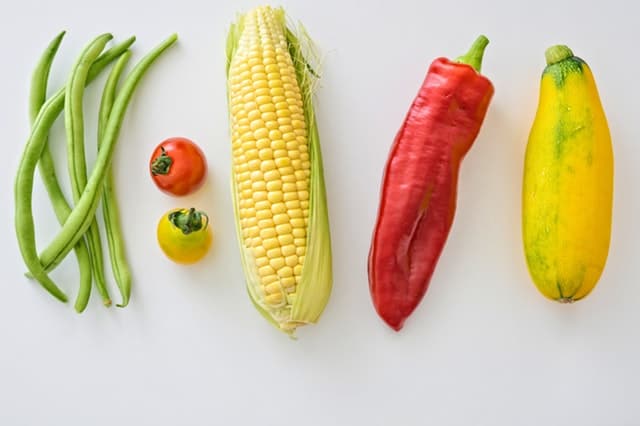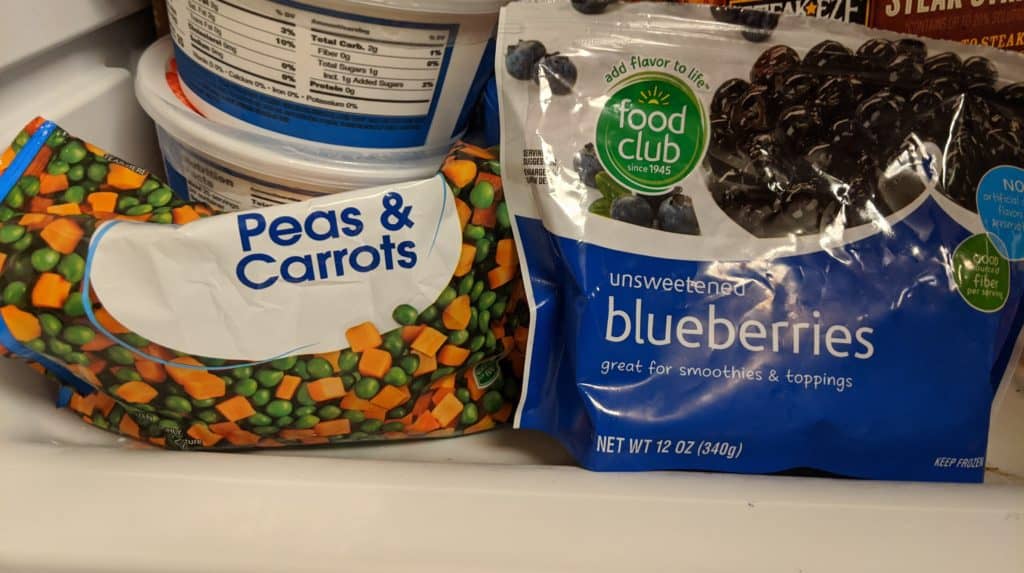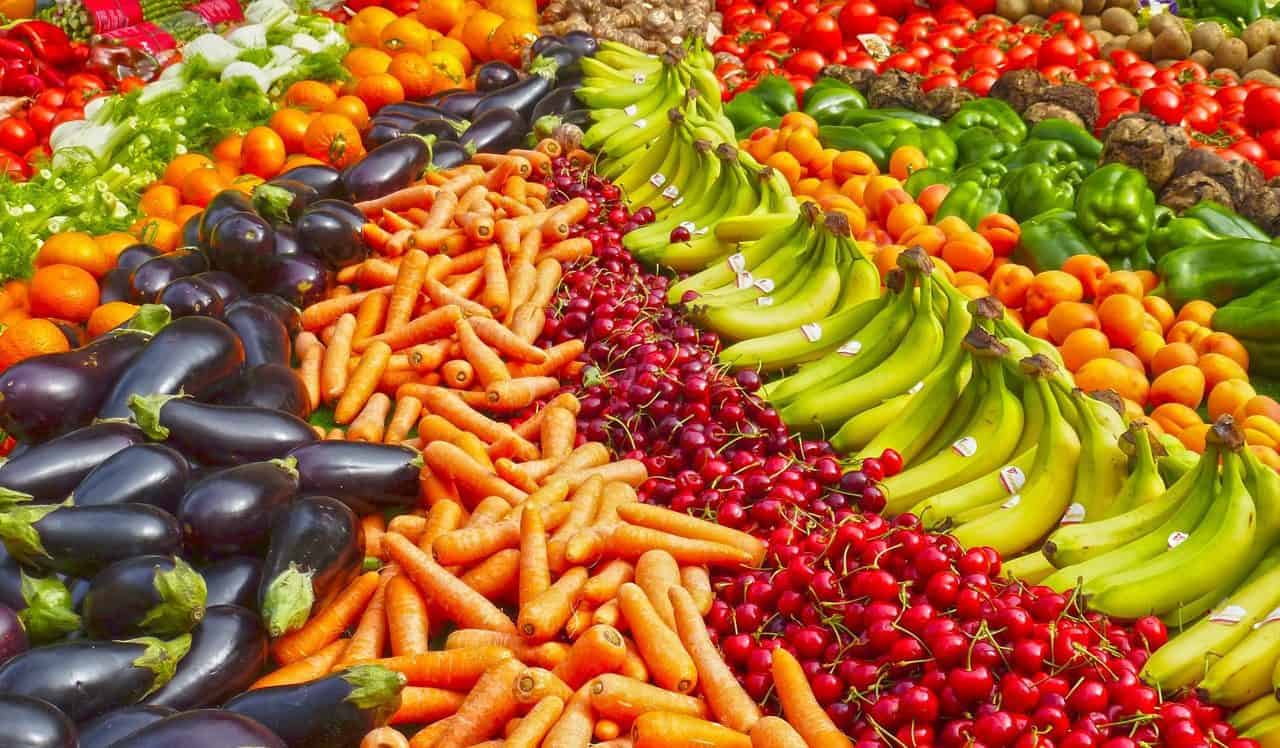Have you ever come home from the grocery store with a car full of fresh fruits and vegetables with the intent to eat really healthy for the week and life gets away from you and those perfect fruits and vegetables are starting to go bad? Or do you have a hard time using all of your garden fruits and vegetables before they go bad? If you are like me you hate to throw them away. So How do you freeze fresh fruits and vegetables?
The process of how to freeze fresh fruits and vegetables can be pretty easy.
- Simply start with ripe and unblemished fruits and vegetables,
- wash and dry them,
- pick any out that are rotten or damaged,
- blanch and shock (vegetables only) by boiling,
- arrange fruit and vegetables in a single layer on a baking sheet lined with a clean dishtowel,
- place in the freezer,
- once frozen transfer to an airtight storage container (freezer bag or vacuum seal bag),
- date and label bags or containers,
- and store in the freezer.
Can fresh fruits and vegetables be frozen?
Yes they can! Well most of them. But don’t wait too long. You don’t want to blanch and freeze rotten fruits or vegetables. You can freeze almost any fruit or vegetable that doesn’t have a high water content. Things like celery or lettuce and cucumbers tend to get soggy when they are frozen and then thawed.
How do you freeze fresh fruit?
- Start with ripe and unblemished fruits.
- WASH and DRY all fruit.
- Pick out any that are rotten or too damaged
- Arrange fruit in a single layer on a baking sheet lined with a clean dish towel
- Place in freezer
- Once frozen transfer to an airtight storage container, freezer bag or vacuum seal bag
- Date and label bags or containers
- Store in the Freezer
You want to start with ripe unblemished fruit. Freezing the fruit is going to change it slightly so you don’t want to start off with fruit that is too old. You’ll want to make sure the fruit is clean AND dry. This will help limit how mushy the fruit gets when it thaws. Pick out the bad fruit before you freeze it. There is a good chance it will all be stuck together when you pull it out of the freezer. If you are using it for a smoothie you’ll have to let it thaw before you can get rid of the bad pieces. Placing the fruit on a baking sheet with a clean dish towel in a single layer will help the fruit freeze quickly while the dish towel will help soak up any leftover moisture.

What about fruits that tend to go brown?
For fruits that tend to brown like apples or peaches, cut up the fruit and dip it in a acidulated water bath before drying and freezing. An acidulated water bath is about one quart water plus a tablespoon of lemon juice. Peaches and pears are some of the only fruits that can also be blanched like vegetables before being frozen to preserve flavor and texture. See *How to blanch vegetables to learn how.
How to store frozen fruits?
When storing frozen fruit you want to put it in an air tight container with as little air as possible inside or a freezer zip-lock bag with little to no air inside. If you can vacuum seal it that’s even better.
How do you freeze fresh vegetables?

- Start with ripe and unblemished vegetables.
- Wash all vegetables
- Blanch and then Shock vegetables (See how to blanch vegetables before freezing below)
- Dry vegetables thoroughly
- Arrange vegetables in a single layer on a baking sheet lined with a clean dish towel
- Place in freezer
- Once frozen transfer to an airtight storage container, freezer bag or vacuum seal bag
- Date and label bags or containers
- Store in the freezer
Blanching vegetables is quickly boiling or steaming the vegetables and then shocking them in an ice bath to prevent cooking. It takes some time but will make a big difference in the long run when it comes to texture and flavor of vegetables.
Blanching vegetables before freezing inactivates the enzymes. Following the recommended times for blanching each vegetable is important. Over-blanching results in a cooked product and loss of flavor, color, and nutrients. Under-blanching stimulates enzyme activity and is worse than no blanching at all.
Blanching cleanses the surface of dirt and organisms, brightens the color and helps retard loss of vitamins. It also wilts or softens vegetables and makes them easier to pack.
How to blanch vegetables before freezing:
- Blanch trimmed, rinsed, and cut vegetables for the time indicated in a recipe or the Blanching Times table below (30 seconds-10 minutes depending on the size and texture of the vegetable).
- When the blanching time is up, quickly drain the vegetables. A flat stainless steel strainer that you can place over the top of the pot is great for this purpose, but you can also use a regular stainless steel colander.
- To stop and prevent cooking, plunge the vegetables into a large bowl filled with ice cubes and cold water, and let the vegetables chill in the ice-water bath for the same amount of time they were boiled or steamed.
- Drain thoroughly, place in freezer-friendly bags/containers and freeze.
How long to blanch vegetables before freezing
The following Blanching Times table is intended as a general guide only – the actual blanching times may differ due to the size and texture of the vegetables being blanched and the blanching method you are using (water vs steam blanching).
| Vegetable | Preparation | Blanching time |
|---|---|---|
| Asparagus | Trim; leave whole or cut to your liking | 2 to 4 minutes |
| Beans, green | Trim off the hard ends | 2 to 4 minutes |
| Beans, snap | Trim off the hard ends | 2 to 4 minutes |
| Beans, wax | Trim off the hard ends | 2 to 4 minutes |
| Bell peppers | Cut into strips | 2 minutes |
| Broccoli | Cut into 1½-inch pieces | 3 minutes |
| Brussels sprouts | Trim; leave whole | 3 to 5 minutes |
| Cabbage | Cut into coarse shreds or thin wedges | 1 1/2 minutes |
| Carrots | Cut into 1/4-inch slices | 2 minutes |
| Cauliflower | Cut into 1-inch florets | 3 minutes |
| Celery | Cut into 1-inch lengths | 3 minutes |
| Chard | Chop or leave whole | 2 minutes |
| Chinese cabbage | Shred the cabbage | 1 1/2 minutes |
| Collard greens | Chop or leave whole | 3 minutes |
| Corn | Leave the ears whole | 7 to 10 minutes |
| Okra | Trim stem ends | 3 to 4 minutes |
| Jerusalem artichoke | Leave them whole | 3 to 5 minutes |
| Kale | Remove the tough stems by hand or using a kale trimmer | 2 minutes |
| Kohlrabi | Cut into 1/2-inch cubes | 1 minute |
| Mustard greens | Chop or leave whole | 2 minutes |
| Parsnips | Cut into 1/2-inch cubes | 2 minutes |
| Romanesco | 1-inch pieces | 3 minutes |
| Squash, summer | Cut into 1/2-inch slices | 3 minutes |
| Sunchokes | Leave them whole | 3 to 5 minutes |
| Tomatoes | Leave whole; peel after blanching | 30 seconds |
| Turnips | Cut into 1/2-inch cubes | 2 minutes |
| Zucchini | Cut into 1/2-inch slices | 3 minutes |
*If you are blanching using the steam method multiply the times above by 1.5 to get best results.
Why should I blanch my vegetables before freezing them?
Blanching the vegetables stops the enzyme action which causes a loss of flavor, color and texture. It also cleans the outside of the surface and helps the vegetables hold onto their vitamins and nutrients.
What if I don’t blanch my vegetables before freezing?
Not blanching your vegetables before freezing will drastically shorten their freezer life. When thawed they will have a different texture and a loss of color and flavor.
Blanching is not used to precook the vegetables before freezing them. It is to help prolong the freezer life of the vegetables.
How to store frozen vegetables?
When storing frozen vegetables you want to put them in an air tight container with as little air as possible inside or a freezer zip-lock bag with little to no air inside. If you can vacuum seal it that’s even better.
In addition to freezing, another great way to preserve vegetables, meats, and low acid foods is through pressure canning. Check out our Pressure canning 101 article – Pressure Canning: The Ultimate ‘How To’ Guide for Beginners
What fruits and vegetables should NOT be frozen?
Fruits
There are a few fruits that should not be frozen including:
- Citrus fruits
- Oranges
- Grapefruit
- Lemons
- Limes
- Watermelon
- cantaloupe
- honey dew
These have a high water content and become soft and mushy with an undesirable texture after being frozen. If you are looking for ways to make melons and citrus fruits last, citrus fruit can be canned or dehydrated. Melons can be pureed and turned into fruit leather.
Vegetables
Most vegetables can be frozen and it works out great. However there are a few vegetables that don’t freeze well including:
- Potatoes
- Celery
- Cucumbers
- Lettuce,
- Parsley
- Radishes
These vegetables will either get too limp or get water logged when frozen. A soggy salad or black potatoes don’t sound too appetizing to me. If you must freeze these vegetables you can sauté them to use in recipes later but they will still have a softer, mushy texture than normal sautéed vegetables once thawed.
How long do frozen fruits and vegetables last in the freezer?

Fresh frozen fruits can last 6 to 9 months in the freezer. Fresh frozen vegetables can last 8 to 10 months in the freezer. If your fruits or vegetables have started to thaw you have a few options. You can cook them, refreeze them, or use them right away and quickly refreeze them. Fruits and vegetables that have been partially thawed that still have ice on them are safe to refreeze.
How can I avoid freezer burn?
Freezer burn is the worst! Pulling something out of the freezer to find it unusable is very frustrating! Although freezer burn is technically safe to eat your fruits and vegetables might not taste quite right.
What causes freezer burn?
To avoid freezer burn you have to know what causes freezer burn. Freezer burn is moisture that has left the food and turned to ice on the outside. This can be caused by a freezer that doesn’t keep a consistent temperature, or is stored in the door that is opened often. It can also be a sign that your food has just been in the freezer for a long time.
How to avoid freezer burn?
To avoid freezer burn look for plastics that are freezer safe, whether that is freezer specific bags or plastic containers. You can also wrap the fruit or vegetables tightly in plastic wrap or tinfoil before you place it in the airtight container or zip-lock bag. Any air that gets into the container or bag will speed up freezer burn.
If you plan on freezing vegetables that have been blanched it is important to let them soak in the ice bath or cool completely before you seal them up. The heat will create steam and condensation in the container which will quickly lead to freezer burn.
How do you use frozen fruits and vegetables?
Fruits and vegetables are best thawed in the refrigerator. However most Fruits that are frozen can easily be put into a blender for smoothies still frozen. Most Vegetables are perfectly fine to go from the freezer into boiling water to be cooked.
Because freezing does change the original texture of fruits and vegetables it is best to use them in recipes rather than eat them like you would if they were fresh.
Fruits
Fruits are best used in baked goods or smoothies. When using frozen fruits in baked goods follow the recipe to see if you should thaw them and drain the extra liquids. If they are not in a big clump you are probably ok to toss them into you cake batter.
Vegetables
Vegetables are best used cooked or in recipes as well. You can fry or boil most vegetables. To fry vegetables pour them into a medium skillet with some olive oil or butter and cook them uncovered for 5-7 minutes while stirring or until they are at your desired texture. We commonly do this with our green beans we have frozen from the summer.


